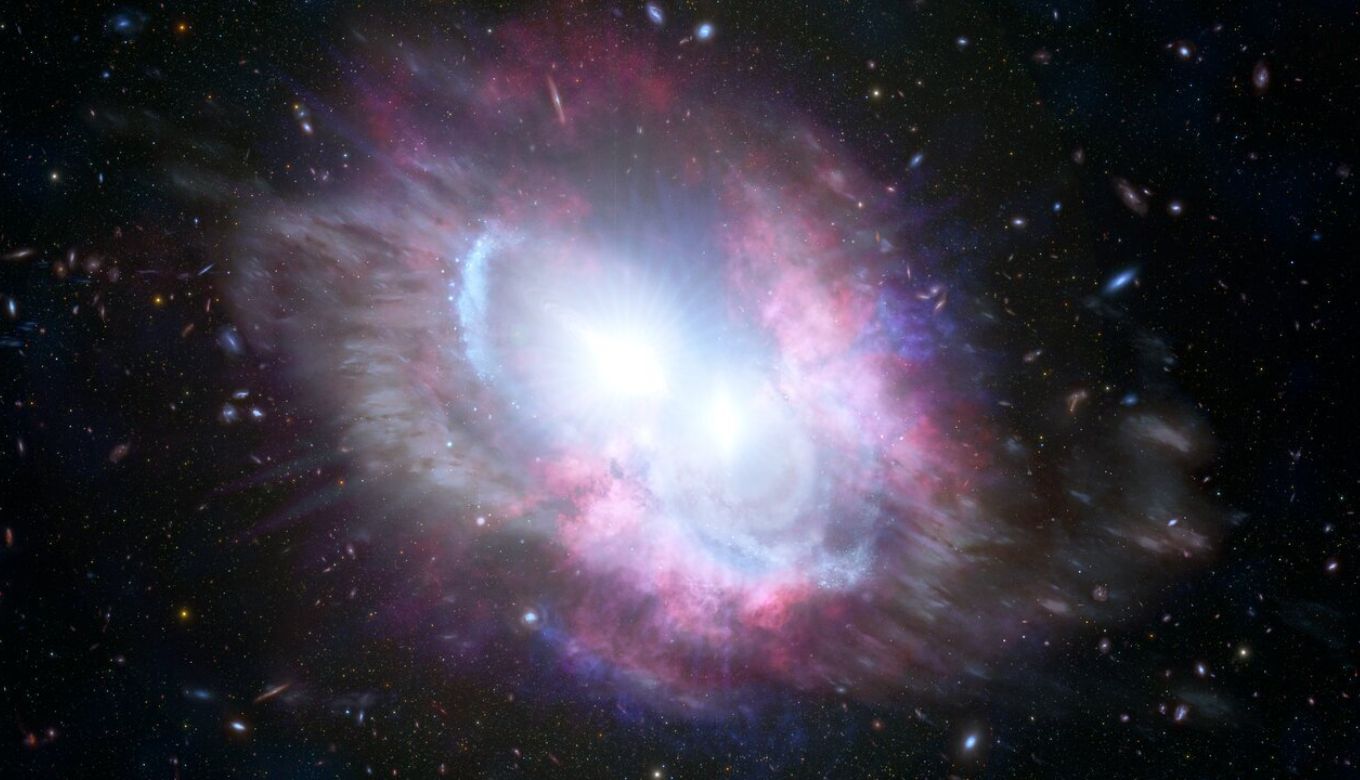Astronomers find that dual quasar or active black holes of the two merged galaxies are on the verge of collision. This is a rare breakthrough discovery
The two quasars or two supermassive active black holes are just 10,000 light-years apart from each other inside the two merged giant galaxies and are on the verge of active collision.
The researchers found that these two galaxies merged when the universe was just 3 billion years young. After merging it becomes a giant galaxy. Inside this merged galaxy, two black holes exist. They named that system J0749+2255.
What is Quasar?

A beam of enormous light generated at the core of the galaxy is called a quasar
Quasars are the extremely luminous active galaxy nucleus. Quasars and black holes are actually different views of the same phenomenon.
1. Black holes are the center or nucleus of the galaxy.
2. Quasars are generated when the beam of jets shoots out toward us from the black holes and we see an enormous amount of light across the electromagnetic spectrum.
How Scientists Discover This Rare Phenomenon of Dual Quasar in Merge Galaxy?

The brilliant illuminated two quasars residing inside the two merged galaxies. These two quasars are on the verge of collision. (Image Credit: NASA, ESA, Joseph Olmsted
Finding such a rare discovery about the dual quasar found inside the two merged galaxies is an exciting discovery that is a difficult task for the research team.
The study was led by a team of scientists from the University of Illinois at Urbana-Champaign.
J0749+2255 is highly unusual because the system has two active quasars that will eventually collide inside the merged galaxy.
We don’t see a lot of double quasars at this early time in the universe. And that’s why this discovery is so exciting” said graduate student Yu-Ching Chen of the University of Illinois at Urbana-Champaign.
European Space Agency Gaia space observatory first detected the unresolved double quasar, they capture images that indicate two closely aligned beacons of light in the young universe.
Chen and his team then used NASA’s Hubble Space Telescope to verify the point of light were in fact coming from a pair of Supermassive black holes.
For observation, they used different observatory tools -:
- Keck Observatory’s second generation Near-Infrared Camera (NIRC2) poured with its adaptive optics system
- Gemini North NASA’s Chandra X-ray Observatory
- Very large array network of radio telescopes in New Mexico
The researchers confirmed that a dual quasar was not the two images of the same quasar created by gravitational lensing.
An astronomer and co-author Yue Shen of the University of Illinois said “ The confirmation process wasn’t easy and we needed an array of telescopes covering the spectrum from X-rays to the radio to finally confirm that this system is indeed a pair of quasars, instead of, say, two images of a gravitationally lensed quasar,“
Dual Quasar Findings indicate the formation of today’s giant galaxies

Hubble Telescope snapped the image of a double quasar inside the merged galaxy. The double quasar in reality 10,000 light years apart and will eventually collide and form a supermassive black hole. (Image Credit : NASA, ESA, Yu Shen, Hsiang Chih Hwang, Nadia Zakamska)
The world’s biggest observatory telescope searched so many things about the universe and about its past, but they didn’t find any dual quasar. So they thought dual quasar no longer exist.
According to the previous observation over the intervening 10 billion years of the universe, small galaxies merged into today’s giant elliptical galaxies. And quasars merged to become a gargantuan or super-massive black hole at its center.
The nearby giant elliptical galaxy M87, has a monstrous black hole weighing 6.5 billion times the mass of our sun.
Maybe this black hole grew from one or more galaxy mergers over the past billions of years.
Astronomers believed and the evidence supports the idea that today’s large galaxies are formed from the merging of the smaller galaxies.
During that process, a pair of supermassive black holes are formed within the merging of galaxies.
These new findings about the dual quasar opened a door of new possibilities to study the billions of years old galaxies’ formation from different points of view.
“Knowing about the progenitor population of black holes will eventually tell us about the emergence of supermassive black holes in the early universe, and how frequent those mergers could be,” said Chen
Xin Liu the University of Illinois at Urbana-Champaign said that “We’re starting to unveil this tip of the iceberg of the early binary quasar population“This is the uniqueness of this study. It is actually telling us that this population exists, and now we have a method to identify double quasars that are separated by less than the size of a single galaxy.”
Also Read:NASA Perseverance Rover: Drifting Clouds are Seen on Mars



